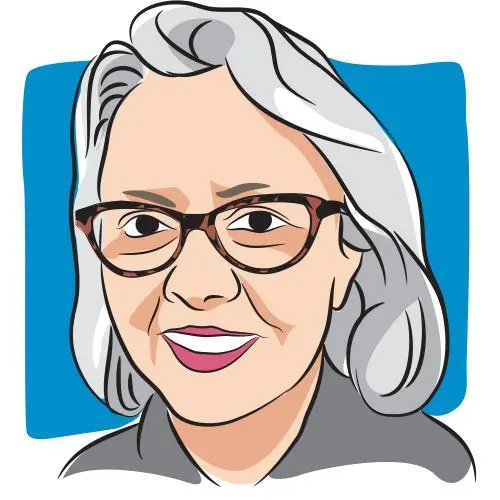Publication
Article
CURE
That Tingling Feeling: New Therapies Are Evolving for Peripheral Neuropathy
Author(s):
Excitement is growing over new strategies for treating or avoiding peripheral neuropathy in patients with cancer.
SUSAN F. ,pictured at her wedding - PHOTO BY JEFF SALMORE PHOTOGRAPHY

SUSAN F., pictured at her wedding - PHOTO BY JEFF SALMORE PHOTOGRAPHY
When Susan F., 51, was diagnosed with stage 4 breast cancer in 2012, she was given multiple therapies, including weekly chemotherapy infusions. Over a period of five months, Susan noticed the cumulative effects of the treatment: Her exhaustion increased, and so did chemotherapy-induced peripheral neuropathy (CIPN), a problem with the nerves associated with sensation and muscle control in the arms and legs. The most common side effects are numbness of the fingers and toes, an uncomfortable feeling and even pain (known as dysesthesias), but CIPN can sometimes also affect strength and coordination, especially when the overall neuropathy symptoms are more severe.
“I kept dropping things and was literally falling over,” Susan, of Washington D.C., recalls. “The neuropathy had a crippling effect on me. I worked with a yoga teacher who had an expertise in cancer and I exercised at home, but it still took more than a year for me to get my strength back.”
Taxol (paclitaxel), a taxane-based chemotherapy often used to treat breast cancer and the one given to Susan, is a prime culprit. Some studies have shown that neuropathy from Abraxane and other taxane chemotherapies is dose-dependent, and its effects build over time. A schedule of one larger infusion per week, as opposed to more frequent smaller doses, also has been implicated, though not all studies have found this to be the case.
Karen Lisa Smith, M.D., a medical oncologist specializing in breast cancer at Sibley Memorial Hospital in Washington D.C., has noticed in her practice that weekly Abraxane causes “a bit more neuropathy.” She prescribes the antidepressant Cymbalta (duloxetine) to patients experiencing pain, but has seen no consensus in the data about the effectiveness of medications to treat the other symptoms of neuropathy. “Drugs aren’t necessarily the answer,” Smith notes. “Right now, treatment options are limited.”
This is unfortunate, considering the number of patients and survivors who suffer from CIPN. Although estimates vary, one large study based on a comprehensive review of the literature found that about 68 percent of adults with cancer reported neuropathy in the first month following any type of chemotherapy. At three months, 60 percent still had the condition. Six months following the end of treatment, 30 percent were still suffering from CIPN. While the medical literature had long suggested that peripheral neuropathy was temporary and usually resolved, reports such as these are now indicating that long-term impact may occur more often than previously understood.
Other studies have reported even higher rates, with symptoms lasting much longer. Kerri Winters-Stone, Ph.D., a research professor at Oregon Health and Science University (OHSU) in Portland, who studies CIPN within the context of exercise trials designed to improve functioning, found that, among 462 women who were an average of six years past their cancer diagnosis and had been given chemotherapy for breast, lung, colon, ovarian or blood cancers, 45 percent still reported some symptoms of CIPN.
“The prevalence exceeded what I was expecting,” says Winters-Stone. “The condition has a major impact on quality of life. Women with neuropathy have almost a twofold greater risk of falling compared to women without this problem. It’s clear that we can no longer dismiss neuropathy as a treatment side effect that goes away, especially since it persisted for years for almost half of the women in our study.” Susan can attest to neuropathy’s lingering effects. While hers didn’t last that long, it had a profound impact on her life during its most acute period.
“I had a couple of serious falls,” she remembers. “I fell on the pavement coming up over a curb, landing on my cheek. At home, getting out of the bathtub, I hit the edge of the tub and then hit the floor hard. That was a bad one.”
RESEARCH YIELDING MUCH-NEEDED INFORMATION
The latest statistics from the American Cancer Society put the number of breast cancer survivors in the United States at 2.8 million. As the numbers continue to grow, so does awareness of CIPN.
To try to add to the arsenal of treatments for CIPN, researchers are accelerating their efforts to understand the causes of this side effect and who is likely to develop it. As this knowledge evolves, progress is being made toward developing effective treatments and uncovering preventive measures. Still, many questions remain.
A study published in the Journal of Clinical Oncology in 2016 is a case in point. Using records from 1,401 patients in the Southwest Oncology Group database linked with Medicare data, researchers were looking for a connection between neuropathy and seven common conditions — diabetes, hypothyroidism, high cholesterol, hypertension, varicella zoster (shingles), peripheral vascular disease and autoimmune disease — among women receiving either Abraxane or Taxotere (docetaxel), another taxane-based chemotherapy. They were investigating whether the type of chemotherapy, as well as the health status of the patients, resulted in the occurrence of neuropathy. The results shed light on both of these issues. Women receiving Abraxane were almost twice as likely to develop neuropathy as those on Taxotere. Of the seven conditions studied, patients with a history of diabetes were the ones with a higher risk of developing neuropathy.
“We need to think if these patients should be targeted for specific interventions, like tighter glucose control, to see if the symptoms can be prevented,” says Dawn Hershman, M.D., professor of medicine and epidemiology at Columbia University in New York and the study’s lead author. “Exercise and weight control may prove to be important — and there is research looking into both of those.”
A surprising finding that emerged from this study was that patients with autoimmune disease appeared to have a lower risk of developing neuropathy. While the researchers aren’t sure what protective mechanism is involved, they have some ideas.
“It’s possible that the inflammatory state of autoimmune disease releases proteins that protect patients from chemotherapy toxicities or that treatments for autoimmune disease, such as steroids, may reduce the patient’s risk,” Hershman explains. “We’re working with our neurologists and laboratory scientists to see if this finding can be replicated in animal models.”
In a prevention study targeting women receiving Abraxane weekly for at least 12 cycles, Hiroshi Ishiguro, a researcher from Kyoto University in Japan, tested whether wearing frozen gloves and socks before infusion, during the session and after the chemotherapy drip was completed helped lessen the problems associated with neuropathy, possibly by lowering blood flow and protecting the nerves from chemotherapy damage. Each patient wore a frozen glove and sock on one hand and foot only, using the other hand and foot as a control by which to measure the success of the intervention. The design of the study called for each of the 36 patients to wear the frozen glove and sock on their dominant side, with the other side acting as the control. Using the Semmes-Weinstein monofilament test, which is designed to detect sensation, Ishiguro and his team found that the tactile threshold was lower for the experimental hand (28 percent) than for the control (81 percent). This means that the experimental side could pick up sensations more readily. Similar findings were documented for the feet: A 25 percent tactile threshold was reported for the experimental foot, compared to 64 percent for the control group. Overall, the study found that, after 12 cycles of Taxol, the incidence of CIPN for the hands was 3 percent on the experimental side compared with 42 percent on the control side. For the feet, the difference was 3 percent compared to 36 percent.
“Although small, our study shows that frozen gloves are beneficial for people undergoing chemo with Abraxane,” says Ishiguro. “What’s still missing is data on who will get neuropathy. Patient factors such as age do not seem to be predictive, nor does drug metabolism. This issue has not yet been resolved.”
The gloves and socks used in the study, which Ishiguro got at a discounted price, cost about $80 each. Ishiguro pointed out that the gloves and socks are reusable and called the method “very cost-effective.”
RETRAINING THE BODY AND THE MIND
With research still ongoing, what can be done to help breast cancer survivors suffering from neuropathy right now? Two approaches — one focused on the body and the other on the mind — are showing promise: exercise and neurofeedback. On the exercise front, a small study led by Ian Kleckner, Ph.D., of the University of Rochester Medical Center, compared the impact of formalized versus random exercise on patients — the majority of whom (78 percent) had breast cancer — undergoing chemotherapy. Of the 314 patients in the study, one group was prescribed a home-based, personalized exercise program that incorporated daily walking and exercises using resistance bands. The second group, the control, were encouraged to exercise, but received no formal support.
Findings showed that exercise was helpful, particularly for older patients. According to Kleckner, the patients prescribed the specific exercise program experienced very little increase in CIPN, while those in the control group noticed a large increase after six weeks of chemotherapy.
Winters-Stone from OHSU has been working with cancer survivors for quite a while, with the hope of improving the functioning of women who have had symptoms of CIPN for many years. To accomplish this goal, she and her team are studying how CIPN affects movements so they can develop safe exercise regimens.
For example, their study found that many women with CIPN have trouble getting in and out of a chair and have an altered gait, which puts them at a higher risk of falling. Based on these findings, it is probably safer for these women to walk on a treadmill with handrails rather than outside, where surfaces can vary and obstacles like curbs need to be negotiated; it’s also good for them to do exercises that improve their balance. The hope is that, after going through a specialized program, women can then join a mainstream gym feeling more confident and less worried about their safety.
Winters-Stone believes that early detection may be the best way to either prevent the devastating effects of CIPN or catch them before they escalate. Her research team has received a grant to develop a remote sensing device that can assess baseline functioning and track symptoms of neuropathy. “Our goal is to preserve functioning,” says Winters-Stone. “Early intervention, before the CIPN gets bad enough to cause falls and functional problems, may be the best way to do that.”
For the many women whose symptoms were not detected early and are now suffering from CIPN, neurofeedback may be a treatment option. Neurofeedback is a conditioning model that retrains the brain in its response to pain and other symptoms. Sarah Prinsloo, Ph.D., assistant professor of palliative, rehabilitative and integrative medicine at MD Anderson Cancer Center in Houston, Texas, is heading up a three-year effort to look at the effects of neurofeedback on breast cancer survivors. This project follows a smaller study, which involved 71 patients, of whom 52 had breast cancer. Among those patients, the majority of the participants receiving neurofeedback experienced reduced pain and an improvement in their quality of life compared to the control group.
During a neurofeedback session, small electroencephalogram (EEG) sensors are placed on the scalp and then connected to a computer. The sensors can track and record brain wave patterns. The participant then plays a series of computer games, with the goal of modifying aberrant waves. When a brain wave has been successfully modified, the participant receives a reward, either by hearing an appealing sound or viewing a pretty picture.
“This kind of learning is unconscious,” explains Prinsloo. “We find that, with repeated practice, usually over a period of 20 sessions, each lasting 30 minutes, the brain learns a new, healthier response to pain and numbness.”
Felecia Peters, 51, was recruited by MD Anderson to participate in its study for breast cancer patients. Diagnosed with stage 2 breast cancer in 2013, she started experiencing symptoms of CIPN while undergoing chemotherapy with Abraxane.
“It snuck up on me,” Peters recalls. “I had numbness, tingling and a sharp, stabbing pain in my feet that would come and go pretty quickly. Balance was also an issue. Sitting down and getting up was painful, as was using my hands to button things and put on small earrings. It hasn’t gone away since my treatment ended two years ago.”
The neurofeedback sessions were not difficult, though Peters remembers feeling sleepy sometimes. “The doctors wanted me to stay awake, but suggested that I nap when I got home,” Peters says. “They said that resting helps the brain remember what it just learned. Unfortunately, I wasn’t always able to follow that advice.”
After completing the 20 neurofeedback sessions, Peters has noticed a significant improvement; she hasn’t felt pain in a while, going up stairs is easier, her fine motor skills are better and she can also exercise more easily.
“I always walked, but now my feet don’t feel as heavy,” says Peters. “While I never fell, it was hard to feel what you were stepping on. It’s a weird feeling, hard to describe.”
As Prinsloo continues to work with women like Peters, she is optimistic that neurofeedback can make a difference.
“Neuropathy is a really debilitating condition,” Prinsloo says. “We’ve seen patients who can’t drive, button their clothes or get around without walkers. They can’t dance or enjoy life as much as they would like. I’m hopeful that our approach will provide these women with lasting relief.”

















